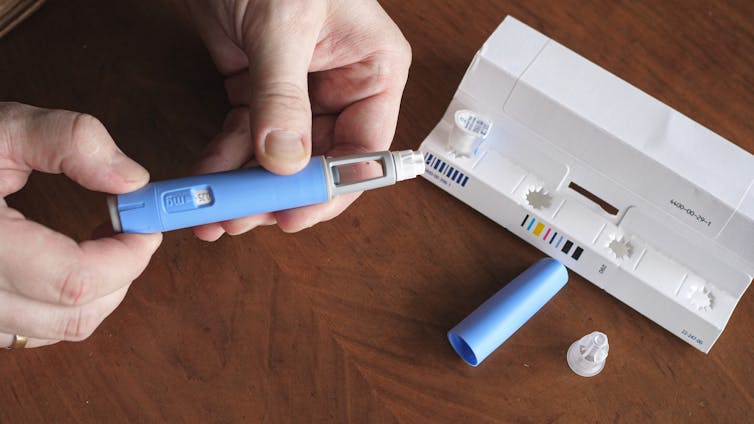Injectable medications originally developed for the treatment of diabetes are also effective for weight loss, and have surged in popularity for this purpose around the world.
In Australia, Ozempic is approved for the treatment of type 2 diabetes, while Wegovy is approved for weight management. Both are formulations of the drug semaglutide, which mimics the action of the naturally occurring GLP-1 hormone on GLP-1 receptors in the gut and the brain, helping regulate appetite and making you feel fuller for longer.
However these medications are expensive, and sometimes hard to get. They also come with side effects. For these reasons, people are taking to “microdosing” weight-loss drugs, or using less than the dose recommended by the manufacturer.
But is this effective, and is it safe? As a GP, people are asking me these questions. Here’s what we know – and what we don’t know yet.
Why are people microdosing weight-loss drugs?
Microdosing usually refers to psychedelic medication, where people take a low dose of a psychedelic drug to enhance performance, or reduce symptoms of stress and anxiety.
However, the term is increasingly being used to describe the use of weight-loss injectables at lower-than-recommended doses.
Three common reasons come up when I ask patients why they microdose weight-loss drugs.
Cost: injectables used for weight loss are not covered by the Pharmaceutical Benefits Scheme, so patients must pay for these out-of-pocket. Costs start from A$260 per month and increase from there.
Availability: worldwide shortages of these injectable medications have led doctors and patients to seek alternative solutions.
Side-effects: side-effects are common, and can include nausea, vomiting, bowel habit changes and reflux. Lower doses cause fewer side-effects, which is why the recommended dosing schedule starts low and gradually builds up.
How do people microdose weight-loss drugs?
A standard dose of semaglutide is 2.4mg, but we start patients on much lower doses (0.25mg) and gradually build up to this by increasing the dose each month. This is because starting at the full dose invariably causes bad side-effects.
Injectables come in an adjustable auto-injector pen which is twisted until the dose counter shows the prescribed dose in milligrams. There’s a click every time the dial is turned. Once the prescribed dose is showing, it’s injected under the skin.
To microdose, patients simply turn the dial fewer times than recommended for the full dose. They estimate a microdose by “counting clicks”, which means they’re turning it according to the clicks they hear rather than until they see the dial showing the correct dose has been reached.
Alternatively, they may inject the full recommended dose but do so less often than once per week.

Is it safe?
Using injectables in this way has not been researched, so the safety has not been established. However, it’s unlikely lower doses would lead to higher safety concerns.
In fact, logically, lower doses are likely to mean fewer side-effects.
But these drugs do expire after a few weeks, and microdosing could increase the risk of inadvertently using them after their expiration date. Injecting out-of-date medication can be a significant health risk. For example, it could cause infection if bacteria has started to grow.
The biggest concern around the safety of microdosing is if patients are doing it without the knowledge of their treating team (such as their GP, dietitian and pharmacist).
Because there are no clear guidelines around microdosing, patients should only try it with caution and under medical care. Their team can assist with issues such as accounting for the limited shelf-life of the medication.
Is it effective?
As lower doses than recommended for weight loss have not been tested, we cannot answer this question yet. However, reduced side-effects at lower doses make it likely there are also reduced therapeutic effects.
In my experience there’s a reason patients increase their doses as recommended: they simply don’t lose enough weight on the starting doses.
At the height of semaglutide shortages in 2023, experts from the American Diabetes Association published recommendations around how to prescribe lower doses for patients with diabetes. But these recommendations were for diabetes management, not for patients using the drug for weight loss.
It’s also important to note that for patients using Wegovy to reduce heart attack and stroke risk – which Australia’s Therapeutic Goods Administration recently approved it for – there’s no evidence that cardiovascular benefits will be achieved at lower-than-recommended doses.
Is there any role for microdosing weight-loss drugs?
There may be a role for microdosing in a few scenarios:
When side-effects are not manageable: when side-effects are intolerable for patients, even on the lowest introductory dose, there may be a role for individualised approaches. But this is best done with clear communication and regular monitoring, so patients are not under-treated.
Supply disruption: if there’s a supply disruption, lowering the dose or lengthening the time between doses may be preferable to ceasing the medication altogether.
Maintenance of weight loss: once therapeutic levels have helped patients achieve their goal weight, lowering the dose may be a helpful longer-term way of keeping them there. We know stopping these drugs altogether results in rebound weight gain. We await evidence for microdosing for weight maintenance.
So what’s the take-home message?
Patients who use injectables as part of their approach to weight loss should be under the care of an experienced team, including a GP, who can monitor their progress and ensure they achieve their weight loss in a safe and sustainable way.
Microdosing weight-loss drugs currently has no clear evidence base, but if a person wants to attempt it, they should do so with the full knowledge of their treating team.
Natasha Yates is a General Practitioner and PhD Candidate with Bond University
Natasha Yates wishes to thank Dr Terri-Lynne South – a GP, dietician, and the chair of the Royal Australian College of General Practitioners’ specific interest group in obesity management – for providing feedback and peer review on this article.
This article is republished from The Conversation under a Creative Commons license. Read the original article.
The statements or opinions expressed in this article reflect the views of the authors and do not necessarily represent the official policy of the AMA, the MJA or InSight+ unless so stated.
Subscribe to the free InSight+ weekly newsletter here. It is available to all readers, not just registered medical practitioners.
If you would like to submit an article for consideration, send a Word version to mjainsight-editor@ampco.com.au.

 more_vert
more_vert
There doesn’t seem to be any evidence that these drugs expire any faster than other medications, or are
more dangerous than other drugs used slightly after their use by date.
I am not aware of a single report of sepsis or death, due to these drugs being used at lower doses so far- and that’s after a huge uptake in usage.
The correct dose is what works for the patient. We constantly see that these medications, are highly effective, for some people, even at low doses.
There is a safe and acceptable dosing range. I see no benefit in the safe lower range being called a micro dose.
There is no real benefit of a dose from the safe upper range being called a macro dose. These terms just instill fear into people that they are under or over dose.
Further more, rapid weight loss leads to hair loss ( alarming for patients but expected if the body is stressed by any type of rapid weight loss ) easy bruising, pressure areas, increased risk of psychiatric side effects such as depression , increased dehydration and renal stones- especially in hot weather, electrolyte disturbances, acute kidney injury encourages gallstones (associated with any type of rapid weight loss in general) constipation, hypotension and falls, unrealistic expectations and exacerbation of eating disorders. These are also not necessarily reasons to avoid GLP1s either.
There is a HUGE variety of situations to dose patients with the lower safe range.
A 65 year old woman who is 110cm, BMI of 35, poor renal function, multiple medications including steroids, osteoporosis, poor balance and rheumatoid arthritis, heart failure has a very different metabolic flexibility from that of a 20 year old testosterone charged male, who is 195cm with BMI of 35. Individual factors are tremendously important,.
And if the macro- drug companies wanted to truly encourage macro-dosing, they could certainly bring the macro- pricing down. But I can’t see micro-prices coming soon.
This article states: “…these drugs do expire after a few weeks, and microdosing could increase the risk of inadvertently using them after their expiration date. Injecting out-of-date medication can be a significant health risk. For example, it could cause infection if bacteria has started to grow.”
This is misleading information, this medication lasting many months as long as it is stored in a fridge.